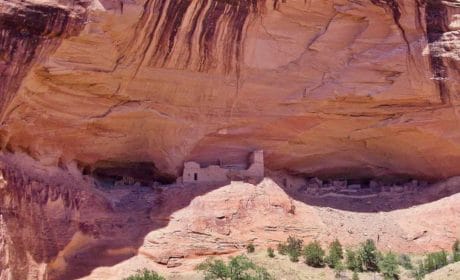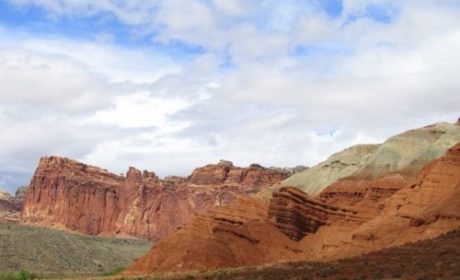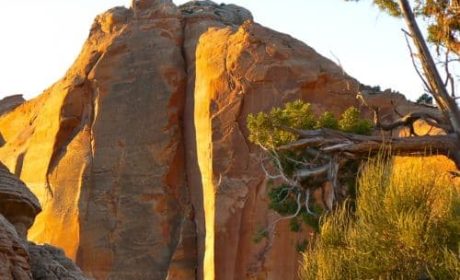Maine offers plenty of things to do for active boomer travelers. But to experience the best of Maine, you’ll want to follow this Acadia National Park itinerary for two days of hiking, lobster eating and exploring coastal Maine from someone who’s been there and done that.
My Itchy Travel Feet featured writer, Debi Lander of ByLanderSea, recently traveled to Bar Harbor, Maine. She returned home with a 2 day itinerary in Acadia National Park that covers the highlights that she experienced and more.
Debi shares tips for a visit to Acadia that’s especially helpful if you’re short on time. Combine this Acadia National Park itinerary with a Maine Windjammer Cruise for the perfect Maine travel experience.
Maine entices visitors away from big cities with its evergreen pine forests, tall craggy mountains, and rocky coasts studded by lighthouses. The Atlantic provides pristine breeding grounds for lobsters, mussels, clams, and scallops. Wild blueberries thrive, especially in northern Maine.
Boaters and anglers find abundant water-based activities, and hikers call the state paradise. New England, in general, makes an especially appealing place for those of us living in hot and humid climates like Florida. Cool temperatures and low humidity create an ideal environment, not to mention the scenic beauty.
Table of Contents
Acadia National Park itinerary for 2 days
Founded in 1919, Acadia National Park (official website) ranks as the state’s crowning jewel. It is listed among the most beloved of our 63 National Parks and, sadly, remains one of the few on the east coast.
By national park standards, Acadia National Park is the 12th smallest, but 10th on the list of most visited, with 4 million annual visitors. Acadia includes 38,000 acres with 65 miles of rugged coastline on Mount Desert Island, Isle au Haut, Schoodic Peninsula, and 17 other small islands.
Our time for exploring Acadia (I traveled there with my boyfriend John) was limited to two days. Follow along as I show you how we made the most of a 2 day itinerary in Acadia National Park.
How to get to Acadia National Park
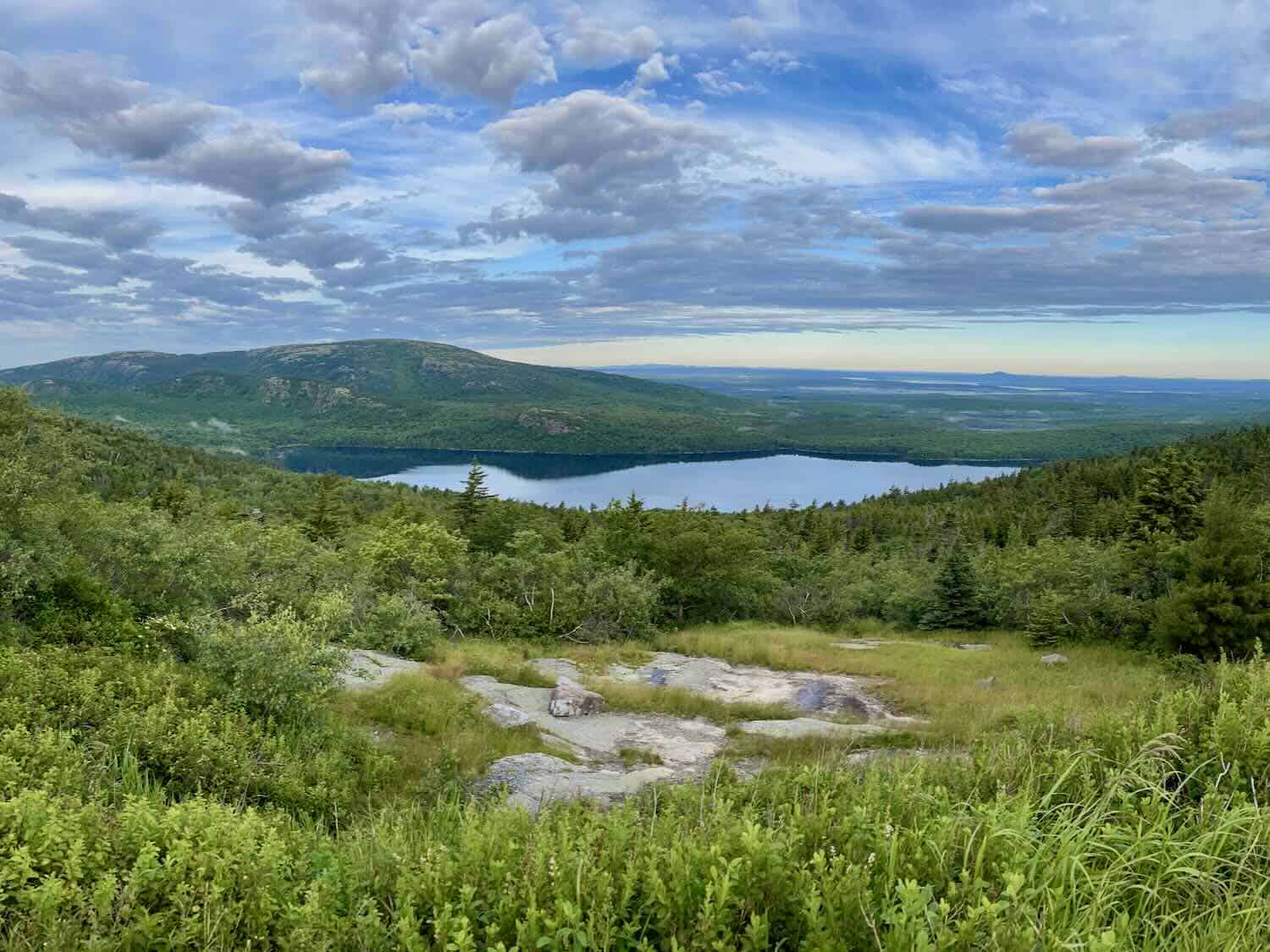
John and I flew from Florida to Bangor, Maine (search for flights here), and rented a car. Mid-Maine is a region where you will need a vehicle to get around (search for car rentals here).
We arrived in the early evening and drove 50 miles to our lodging in Bar Harbor. It’s the small town closest to Acadia National Park.
Other options include flying to Boston and making a 5-hour drive or flying to Portland, Maine, and taking a 3-hour drive. Bar Harbor Airport is only 10 miles away, but only regional aircraft land there.
Where to stay
We’d booked a stay at Queen Anne’s Revenge, a bed and breakfast inn within walking distance of downtown Bar Harbor. The lodging, originally five summer cottages, underwent a complete renovation.
Our nautically themed suite, off the main building, included a living room and fireplace. The bed was very high, making it a bit awkward to get in and out, but really comfy.
The next morning, we found some delicious muffins among the continental breakfast offerings in the main house. We then took off for the park.
You’ll need a national park pass
Everyone over 15 years needs a park entry pass. We picked ours up at the Hulls Cove Visitor Center.
After showing our National Park Senior Passes, the permit was free. Senior passes are one of the best deals you will ever find.
A shuttle bus runs from Hulls Cove, and some folks leave their car as parking can be problematic. If you choose to drive into Acadia, you’ll need a vehicle pass in addition to the park entry pass. Here’s how to apply online.
Boomer Travel Tip
Looking for a national parks books reading list? Here are our recommendations for 52 of the Best National Parks Books.
Day One in Acadia National Park
We begin our 2 day Acadia itinerary with a hike to Sand Beach, blueberry pie and mussels!
The hike to Sand Beach
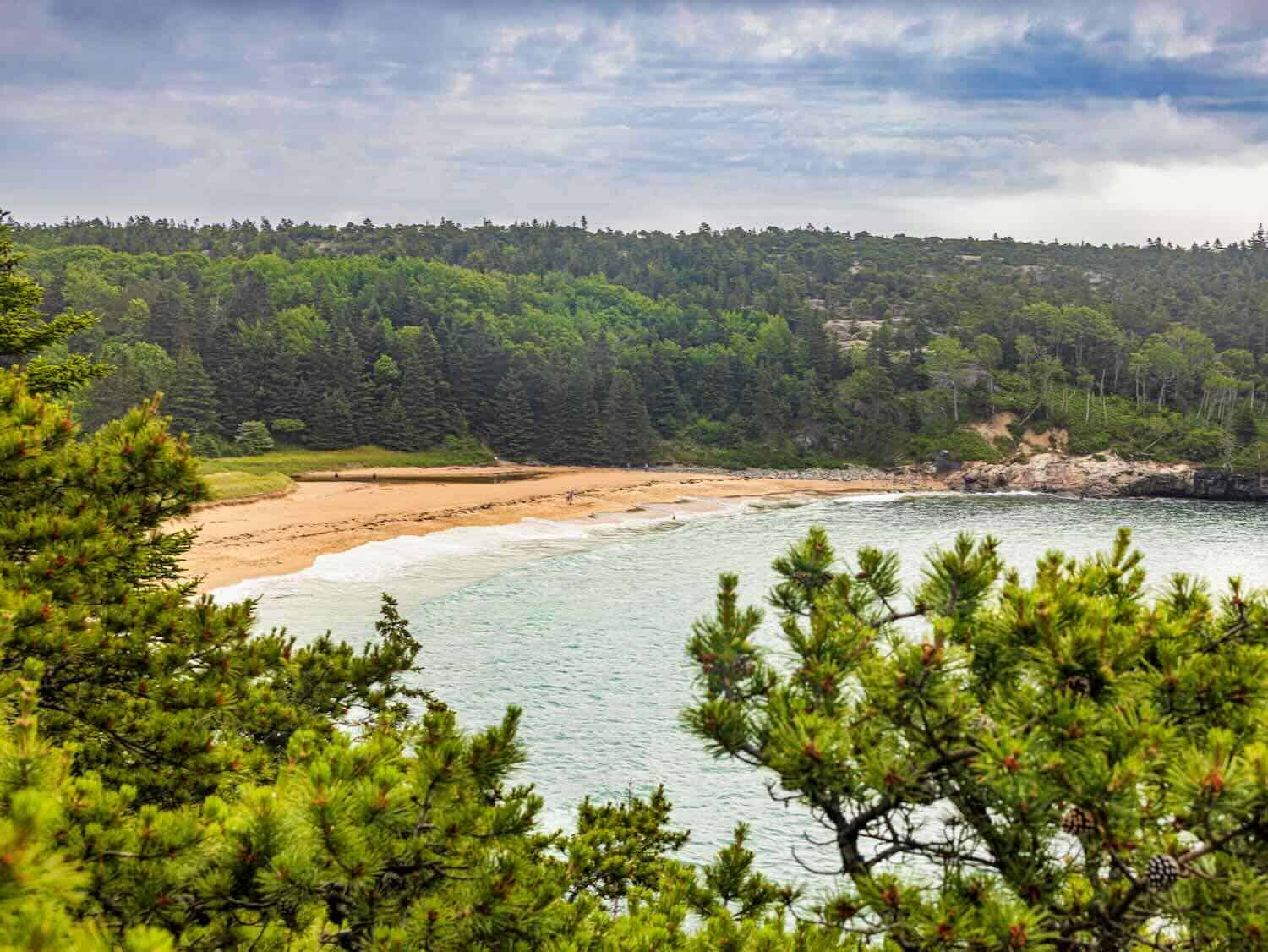
We proceeded to the famed Sand Beach area, parked alongside the road, and began a hike. A few brave souls were swimming, but we Floridians would never consider such cold water.
The parking area leads to a gravel and paved trail 450 feet above the beach and boulder-strewn coastline. You can leave the trail in many places to explore the rocky cliffs, but making progress is easiest along the path. Our goal was to reach the highest point, Otter Point, then return, in total, a 4.4-mile hike.
Stopping at Thunder Hole
We stopped at Thunder Hole along the way, but our timing wasn’t right. The crowded attraction is a small inlet, naturally carved out of the rocks, where the waves rush into a small cavern, and water and air are forced out.
The noise sounds like thunder, and water may spout as high as 40 feet. Unfortunately, we didn’t see the incoming waves batter the hole and make a loud roar because the tide was out and the ocean reasonably calm.
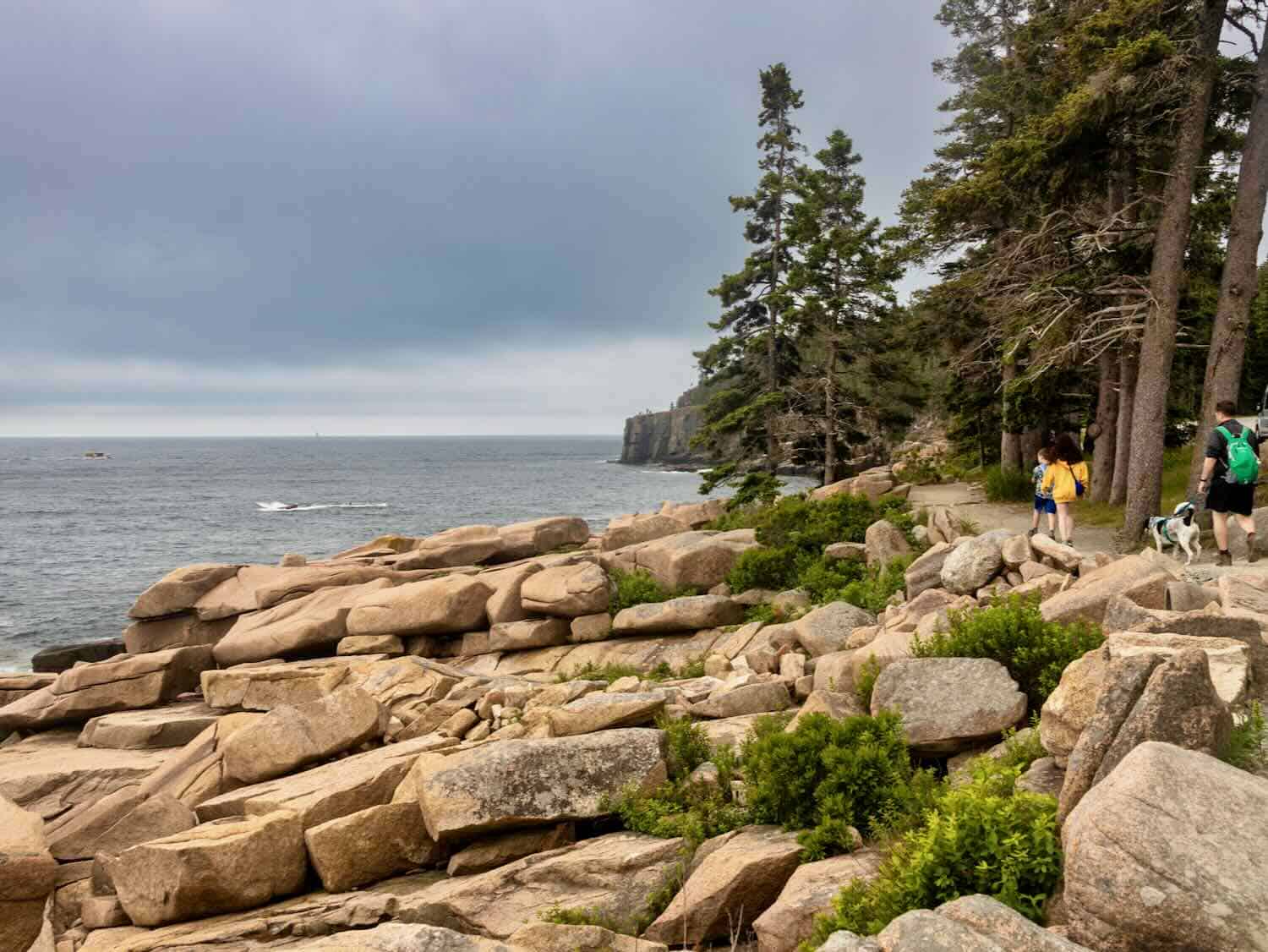
We continued along and stopped to admire the ocean views plus take photos of the rocks and pebble-strewn beach. Each twist and turn brings another evocative picture.
Unfortunately, the sky was gray and overcast as a storm was coming. We kept up the pace to fit in the hike before the rain.
The panoramic view from Otter Point
As we neared Otter Point, the trail ran through a forested area where the red pine scale insect had killed many of the trees. The trees were dry and brown, a sad sight, but new growth was just starting to appear.
Otter Point offers the highest panoramic outlook onto the Atlantic Ocean from this trail. We gazed out to sea and back at the coastline we had just hiked. Although this trail is always crowded, it’s iconic Maine, a must-see.
We returned to the car just as the storm started. Since we had worked up an appetite, we decided to head into town for lunch and return to the park in the later afternoon.
Lunch in Bar Harbor then back to Acadia
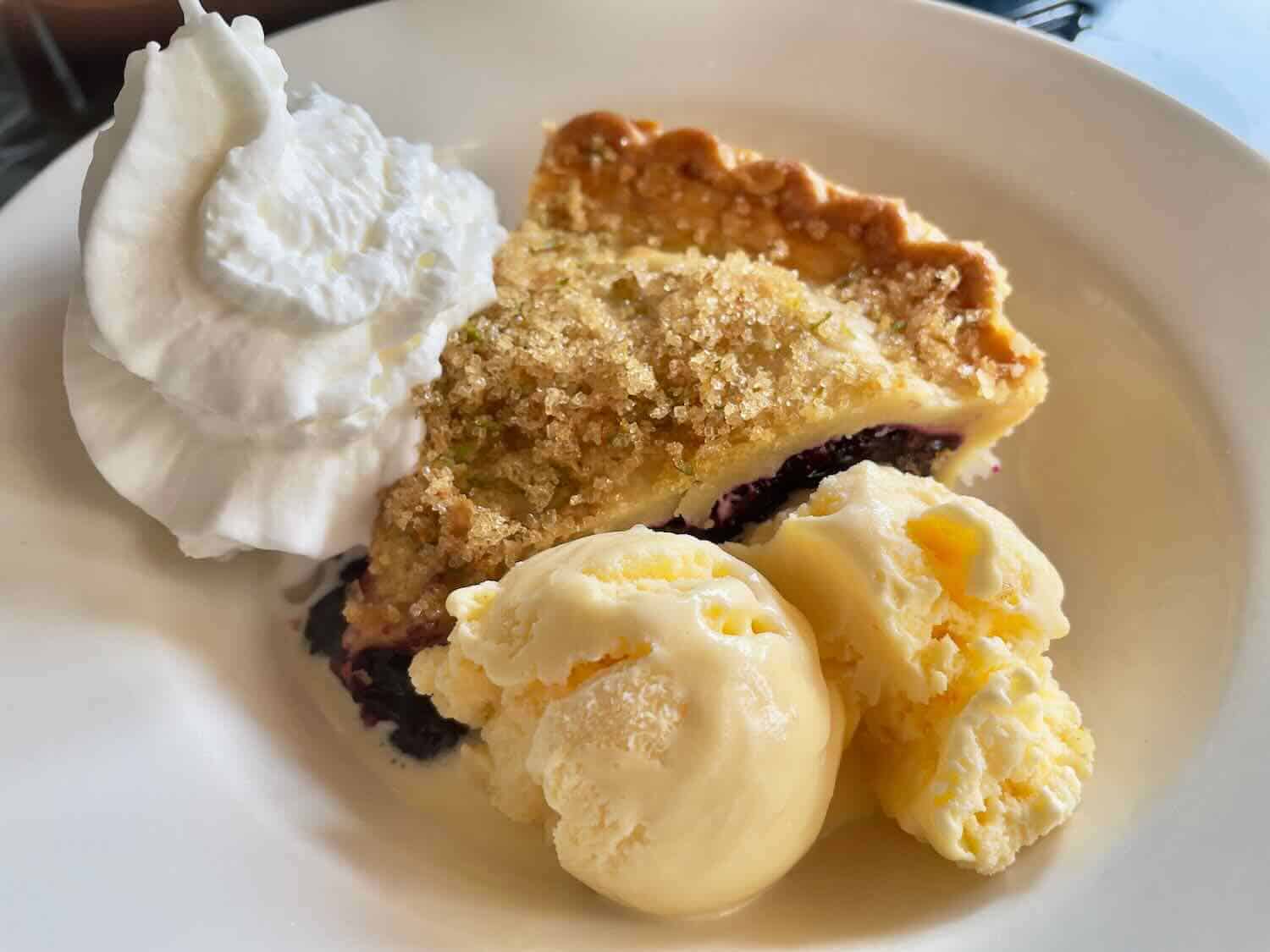
We chose the trendy Side Street Café because the food is excellent. We were in Maine, so a cup of lobster stew and John’s lobster mac n cheese seemed apropos. We could not resist splitting a piece of Maine blueberry pie with a scoop of vanilla ice cream for dessert.
Despite the downpour, we returned to the Hulls Cove Visitor Center, hoping to see a film about the park. No luck. I was disappointed that the center was small and didn’t offer much in the way of merchandise.
Exploring downtown Bar Harbor
The rain continued, so we returned to our bed and breakfast and rested. With the inclement weather and poor photo opportunities, we pulled open the umbrellas and walked into town to explore the shops.
Unfortunately, Bar Harbor has become overrun with tacky tee-shirt stores and cheap souvenir shops. We browsed a few galleries and scouted many of the posted menus at restaurants. We decided we’d return to a Cuban restaurant named Havana, billed as fine American dining with Latin flair.
Dining at Havana
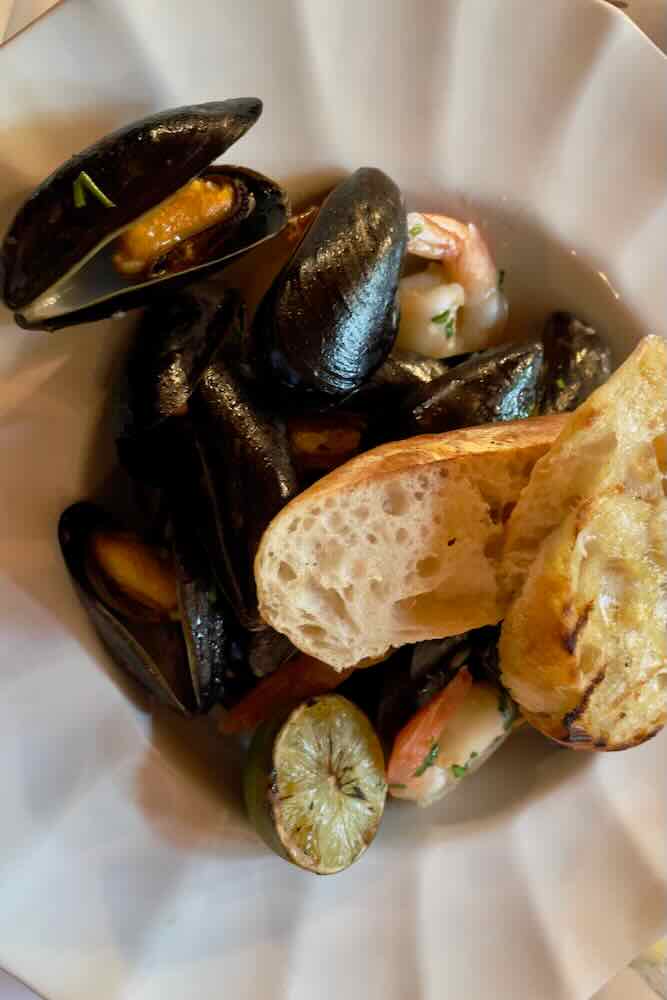
Indeed, Havana became a fine choice; John started with a Havana Martini, and I chose a wine from their extensive list. I indulged in a bowl of local mussels swimming in a buttery sauce that I sopped up with a hunk of bread. The mussels were the largest I’ve ever seen.
The restaurant has been in business for 24 years, so they must be doing things right. Over time, they added connecting rooms, and a new outside Tapas Bar & Grill called the Parrilla is open late.
Day Two in Acadia
On the second day in Acadia National Park, we focused on Cadillac Mountain, Jordan Pond and lobster!
Cadillac Mountain
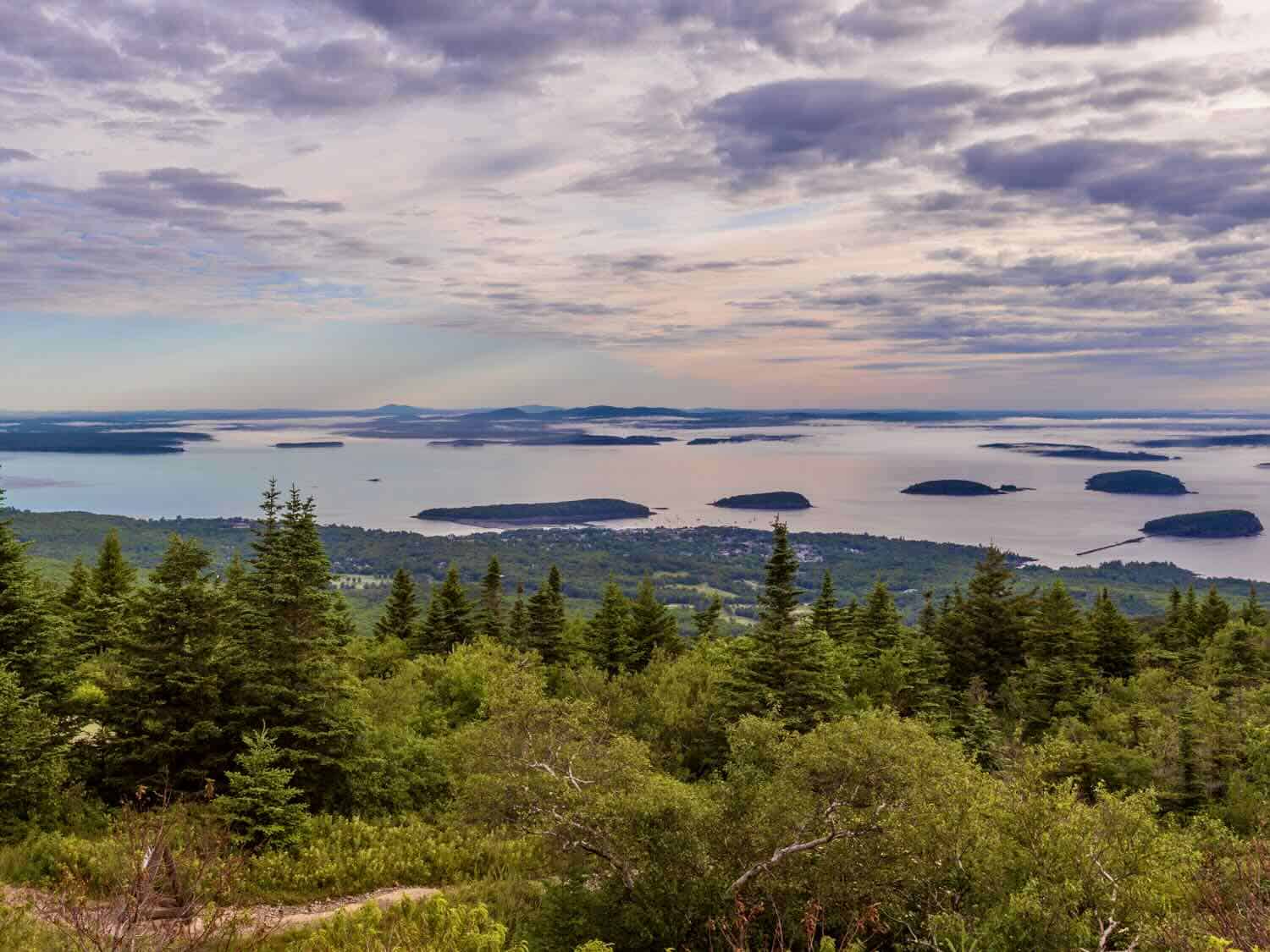
I’d made reservations for 6:30 am entry to the drive up to the summit of Cadillac Mountain, the tallest peak on the east coast. Reservations (fee of $6) are necessary during the summer. Here’s how to reserve online.
Make your plans and reservations as early as you can because they are limited by the available parking spots. However, when we arrived, the parking lot was wide open.
We stopped at one overlook on the way up, and while the vista was rewarding, it was nothing compared to what lay ahead.
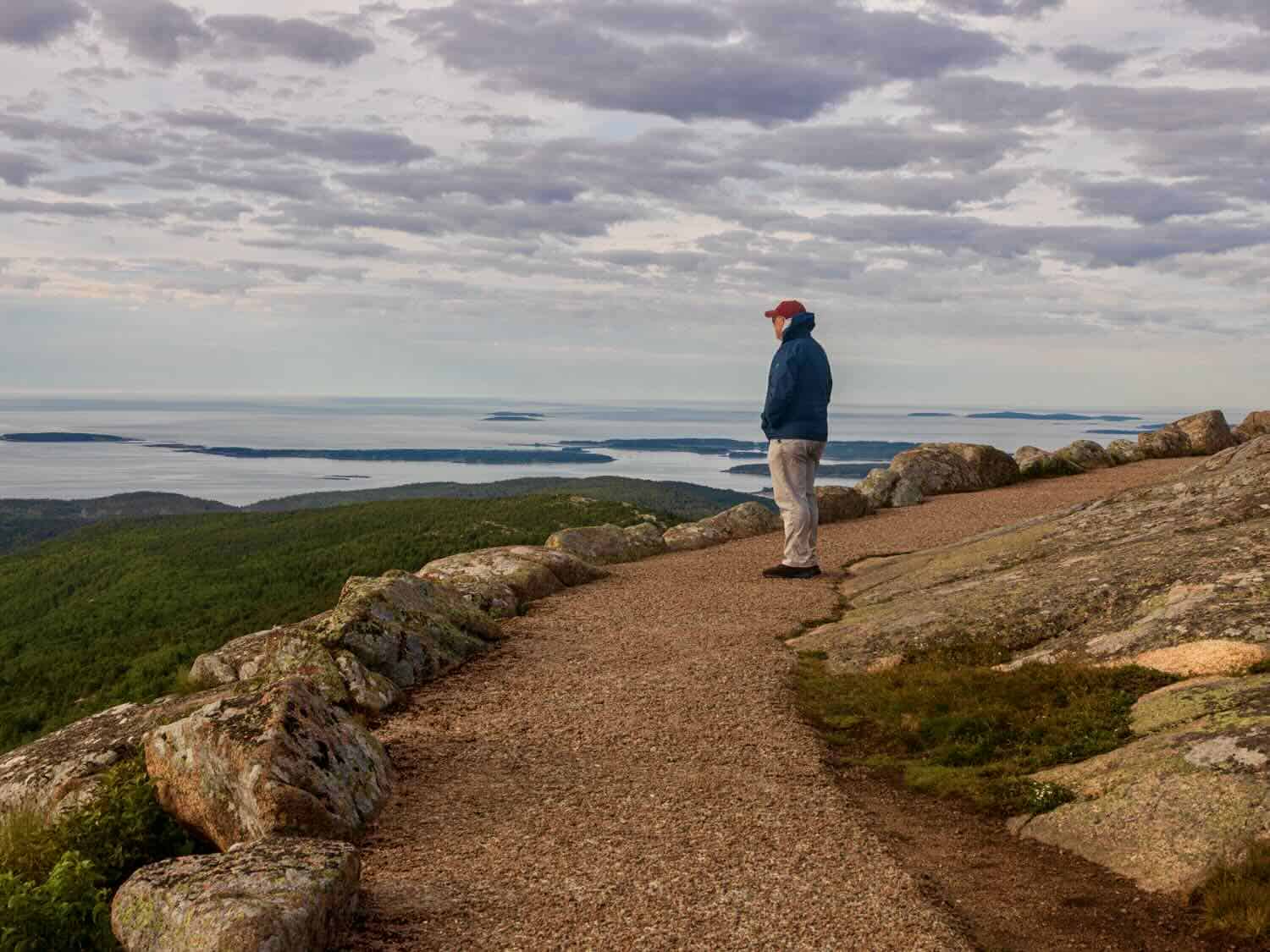
The view from the top of Cadillac Mountain is breathtakingly beautiful, ethereal for sure, and won’t disappoint. The early morning fog was still hanging over many distant little islands.
The water looked true blue, and the sky a creamy mixture of lavender with hints of pale buttery hues to come. The streaky cloud formation delighted all and kept getting better.
A path snakes around the summit letting you stroll and observe about 180-degree views. Parts of the trail are bordered with a yellow-green granite that has eroded into soft mound shapes. It is hard to say which angle is the best; they are all stunning.
Many people come to Cadillac Mountain on January 1st, the first place to view the sunrise in the United States. However, parking reservations are difficult to obtain, and you will likely have to hike up the strenuous trail. That means you’d be hiking in the dark, but I have heard it is worth the effort.
Acadia is open year-round, and while the summer is the busiest time, I suspect the spring or fall would be truly gorgeous.
Boomer Travel Tip
Take a look at our day hiking essentials before heading down the trail.
A walk around Jordan Pond
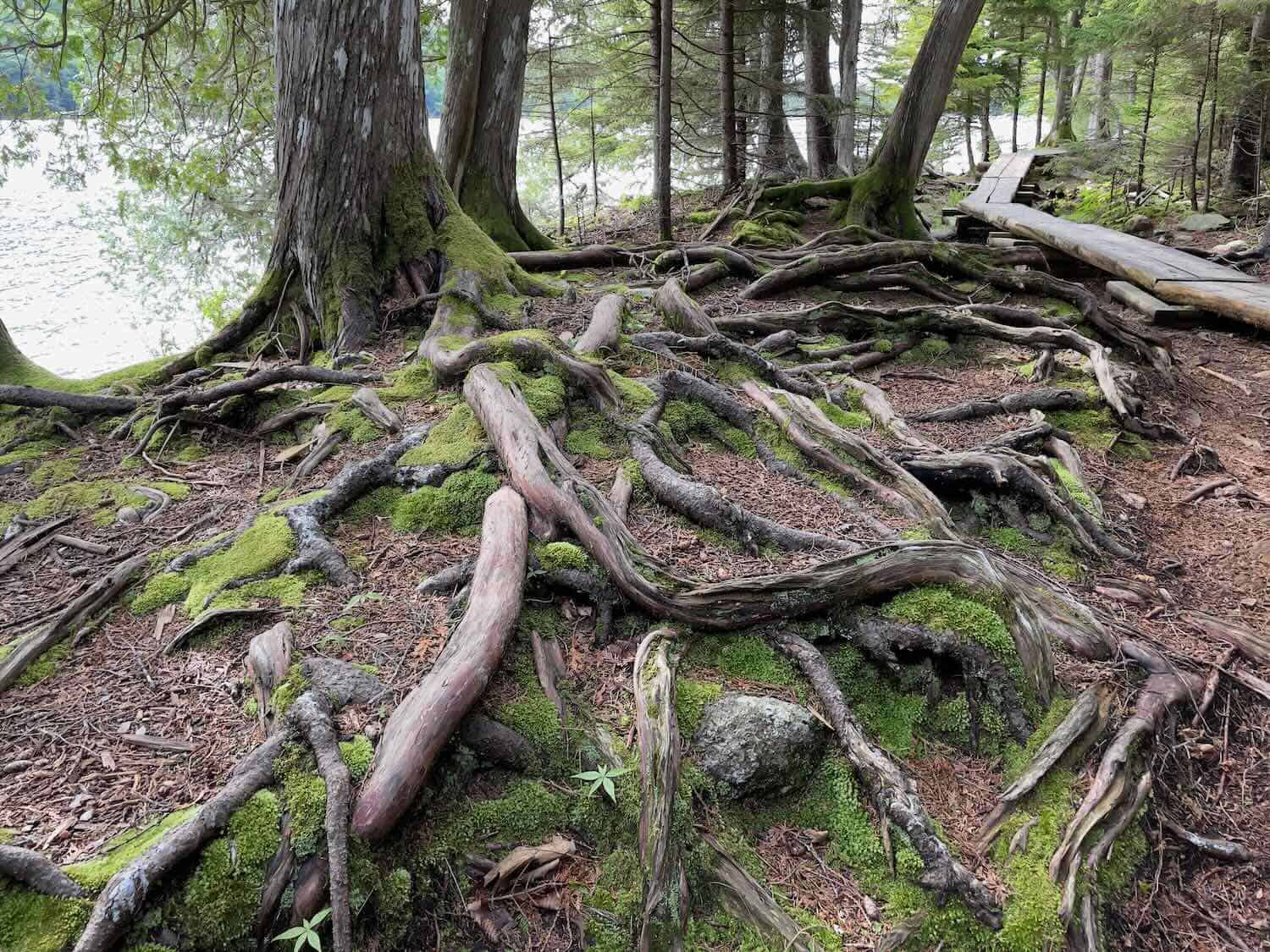
We drove down from Cadillac and went directly to Jordan Pond. Wisely, we had packed a granola bar and apple, which we needed before our 3.5-mile hike around the famed Pond.
The circuitous trail remains relatively flat, but the footing changes. Be sure to wear shoes with a good grip.
Some areas involve stepping over slippery exposed roots. Other regions require you to climb up and down across boulders.
I would not recommend taking younger children on this hike unless you just plan to only do a portion.
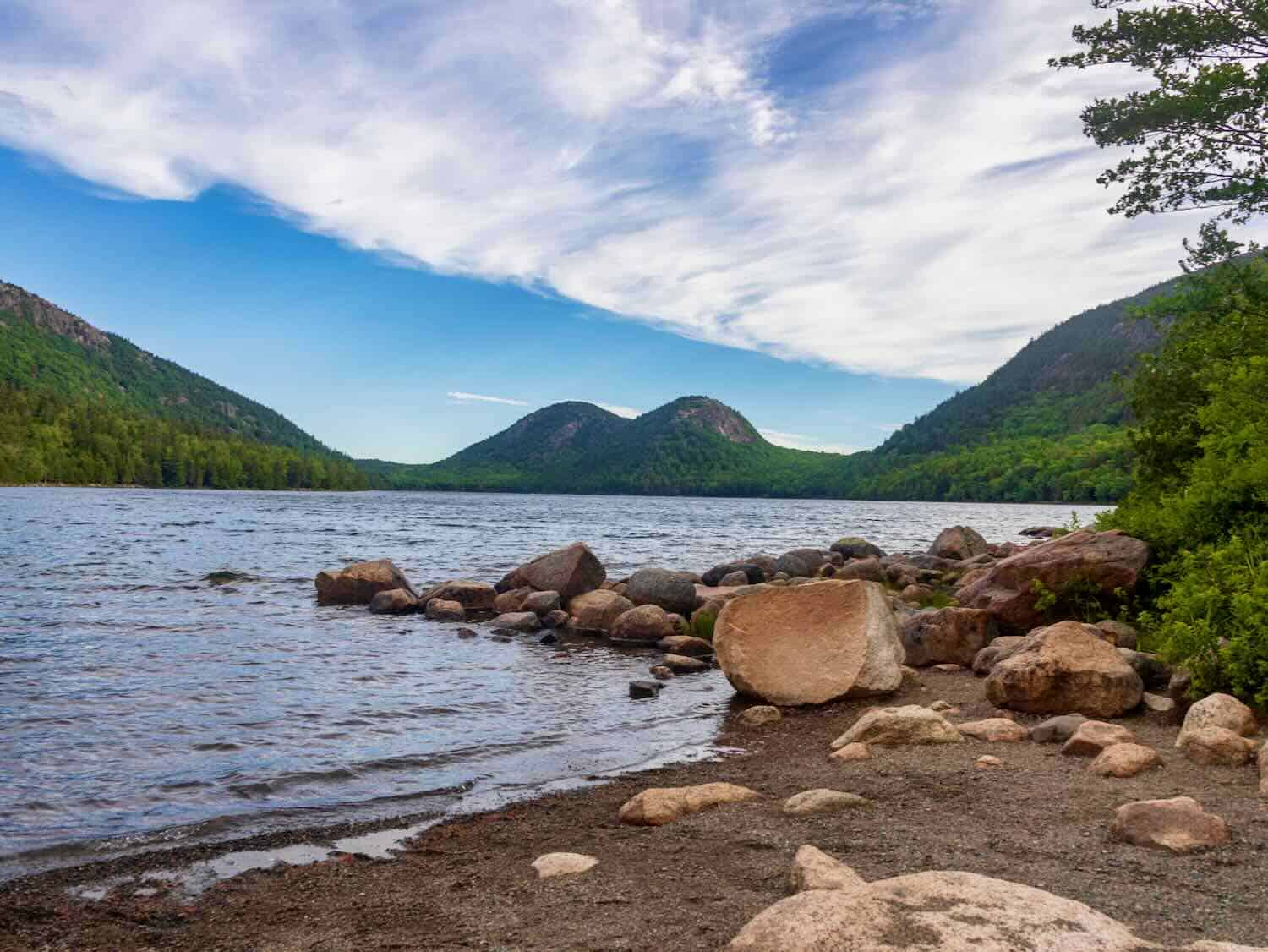
The mid-point of the hike includes a small bridge and a wide-angle view of the water. Above you stand the Bubbles, two mounds that resemble a pair of women’s breasts.
Other trails run off the Jordan Pond path, one leading up to the Bubbles. Always check the trail information before hiking; some include vertical climbs on rungs embedded in the rocks.
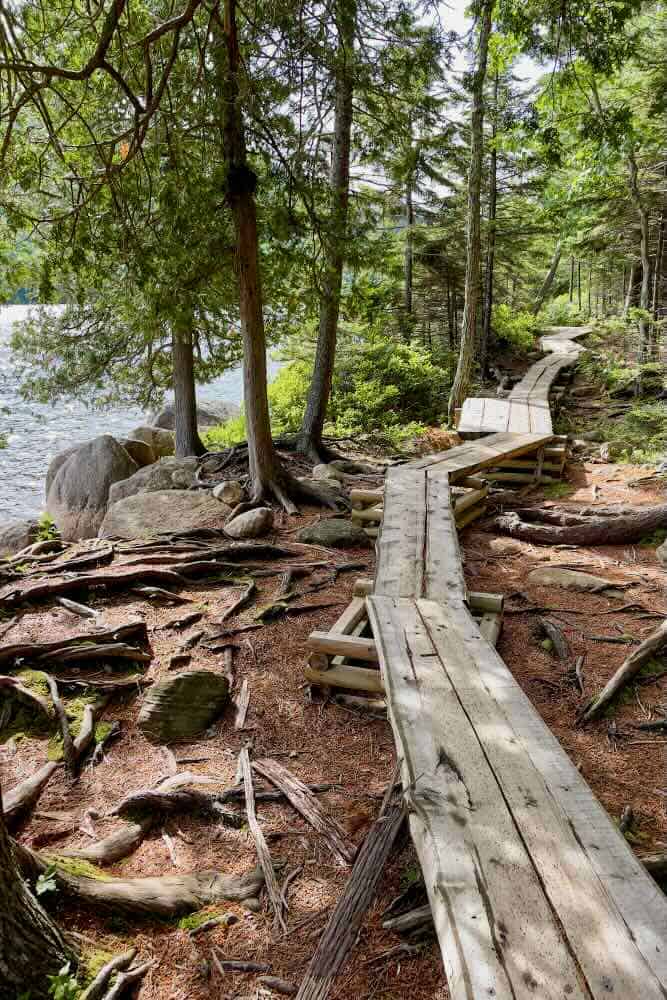
The final trail section for us (closest to Jordan Pond House – the Visitor Center and restaurant) was along a narrow boardwalk of wooden planks. It’s wide enough for one person, but you must be careful if you need to pass another.
Areas that I’ll call passing places (an extra section of planking) await every so often. The hikers coming in the opposite direction were courteous and stayed over if they were closest, and we did likewise for those we saw approaching.
I had read about the famous Jordan Pond popovers served in the restaurant, and I was more than ready to sit down and try one. But we were still too early. The restaurant wasn’t open.
The visitor center store was open and offered all the official Acadia and souvenir merchandise I’d missed at Hulls Cove. However, we desperately wanted a bottle of water. Only then did I remember that the national parks don’t sell throw-away plastic bottles, encouraging you to refill reusable ones at a water fountain.
Since we didn’t bring water on the hike ( a poor decision), we bought a frozen juice pop to quench our thirst. Lesson learned!
Our schedule allowed no time to kayak or canoe on Jordan Pond, but we saw others enjoying that option. You must rent boats in Bar Harbor or elsewhere outside the park. There is no rental concession at Jordan Pond.
As we were leaving the area, we could not believe the hundreds of cars filling the parking lots. What a difference two hours make!
Boomer Travel Tip
Start planning your next national park trip with our National Park Travel Planner!
Bass Harbor Lighthouse
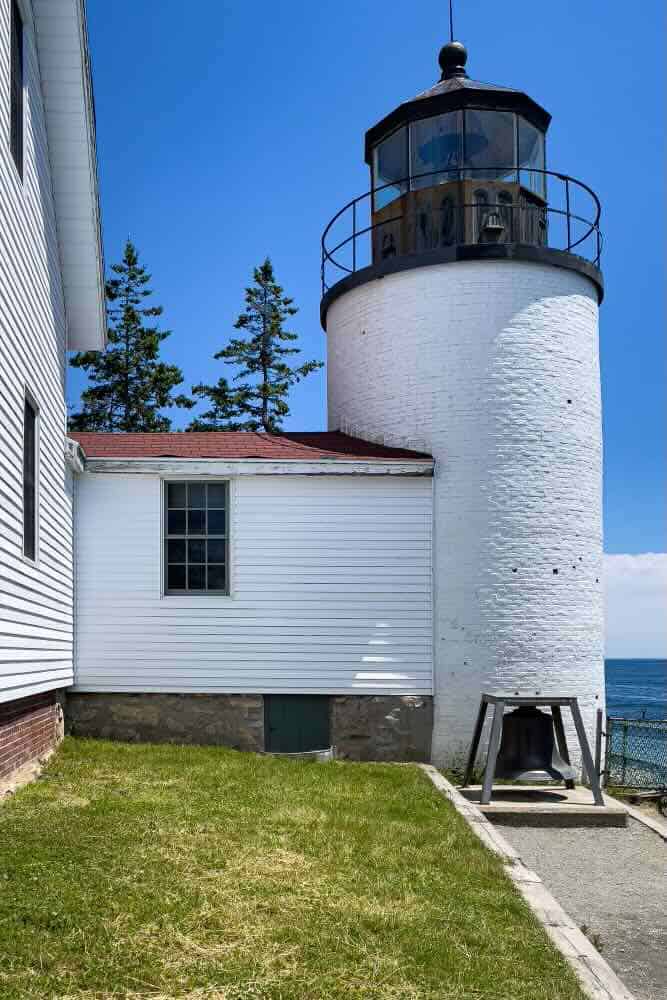
We headed back to Queen Anne’s Revenge to shower, grab a late breakfast, check out, and then venture off to the famous Bass Harbor Lighthouse. The Light Station is located at the tip of the southwestern side of Mount Desert Island, about 17 miles from Bar Harbor or 11 miles from Jordan Pond.
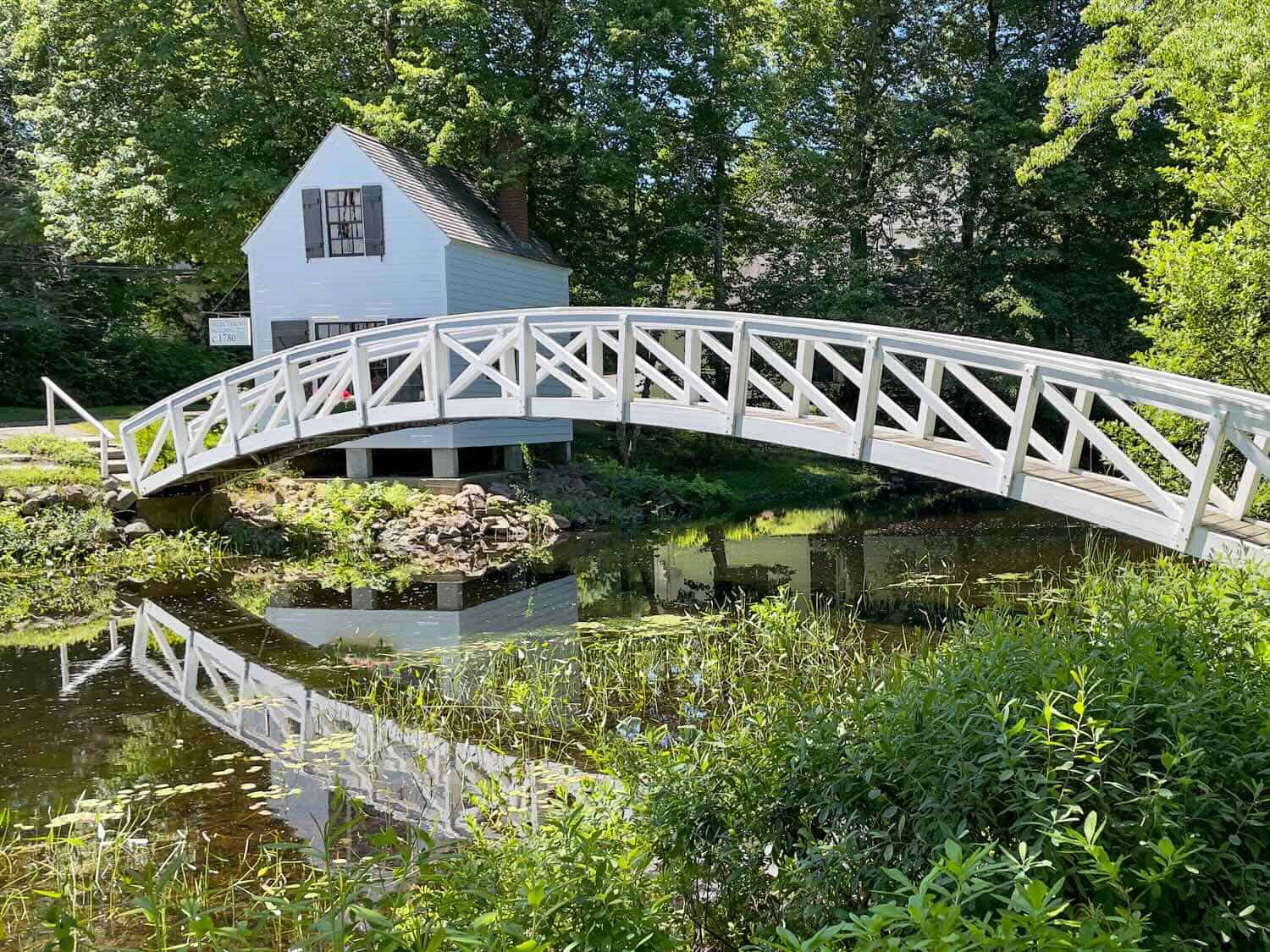
We stopped briefly in Somesville to photograph a charming white bridge I’d read about. It is not officially within Acadia National Park boundaries, but you pass by on your way to Bass Harbor.
The road leading to the iconic lighthouse parking lot was backed up. When one car left, another pulled in. Fortunately, we weren’t stuck in line for too long.
Once we parked, we saw a path on the right side. This takes you to the side of the tower and provides a panoramic view. You’ll pass plaques with detailed information about the grounds, the lighthouse, and its history.
I returned uphill and followed the path to the left (opposite side of the lighthouse), hoping to get a better photo. This path leads to a stairway that drops down the front of the cliff, eventually arriving at a prime spot for capturing a picture.
Beware: there are no guardrails or walkways for safety, so use utmost caution on the rocks. I went as far as I was comfortable, but still not far enough for the photo I wanted.
FYI: The best photos of Bass Harbor are taken from a boat.
The lighthouse still belongs to the U.S. Coast Guard. The keeper’s house remains much in its original form but was not open for tours.
Thurston’s Lobster Pound
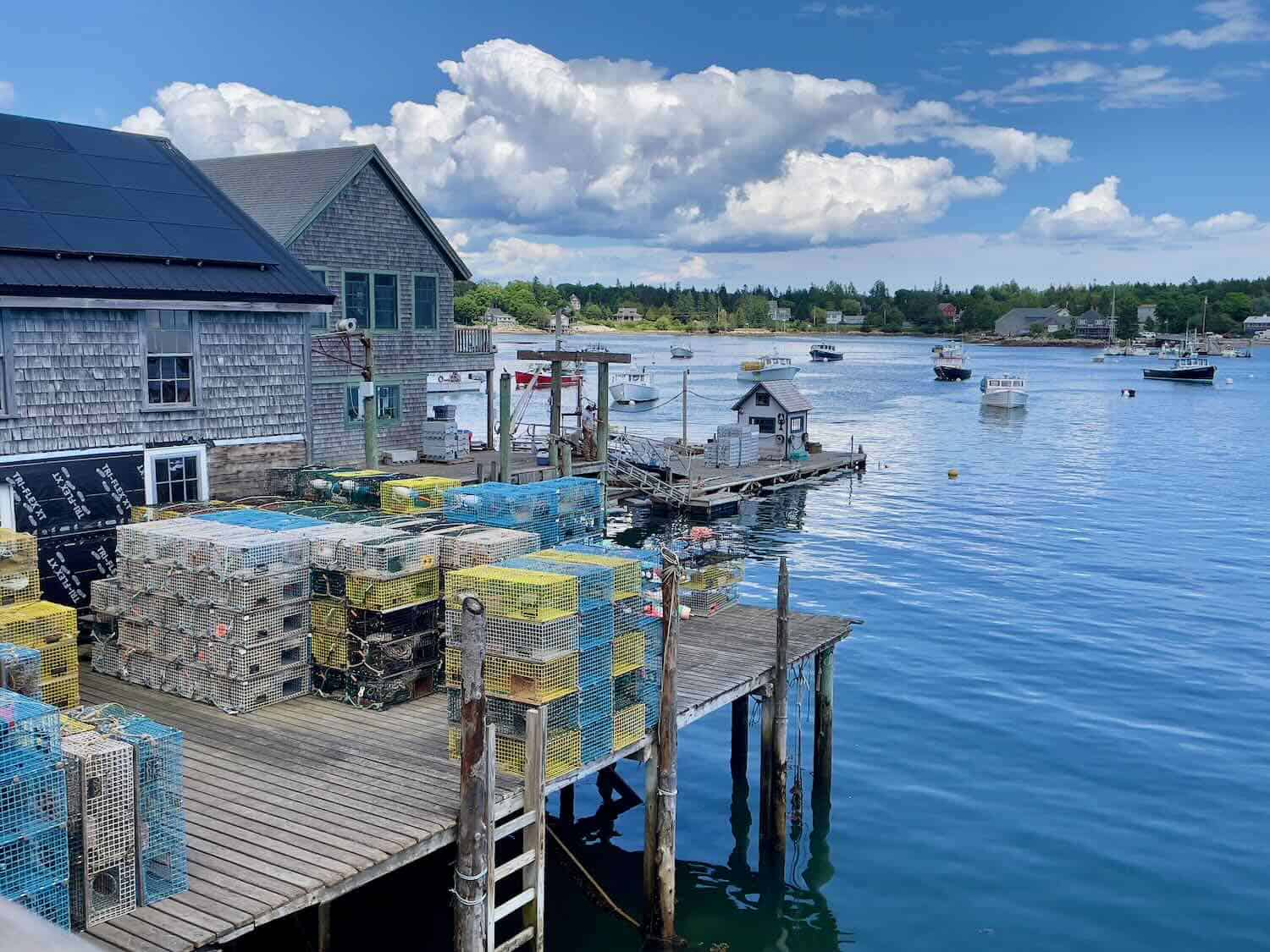
Finding Thurston’s Lobster Pond in Bernard (on Mount Desert Island) is tricky, but don’t miss it. An early lobster dinner was calling.
Thurston’s is renowned for its relaxed atmosphere and fresh-from-the-sea lobsters. It’s always busy, so our timing was ideal.

You pick the size lobster and sides, then sit on the dock hovering over the bay. We watched the real deal, lobster boats returning to the pier with their day’s catch while awaiting our meal.
Reading some signage, I learned that lobstermen can fish up to 800 traps. The metal wire cages sit on the ocean’s floor, are baited with herring, and have several entrances designed to let lobsters crawl in but not out.
Traps are hauled up by a rope where a buoy floats on the surface marking its location. Each fisherman has a unique color and pattern combination painted on their buoys. One of the outside walls of a building at Thurston’s hangs with colorful buoys.
Southwest Harbor
We also stopped briefly in Southwest Harbor, north of Bass Harbor, on our way back. The town has intriguing little shops, galleries, and eateries. (I have to admit I liked it better than Bar Harbor.)
Many people choose to stay here during their visit to Acadia for its more relaxed pace and access to the offshore islands by boat. If you are in the area, don’t miss the Wendell Gilley Museum of Bird Carving – it is widely recognized as one of the early pioneers of this American art form.
Driving the Carriage Roads
Acadia includes 45 miles of rustic carriage roads constructed from 1913 to 1940, the gift of philanthropist John D. Rockefeller Jr. and his family. The roads weave around the mountains and valleys but are concentrated around Jordan Pond.
Rockefeller wanted to preserve the line of hillsides and save trees, align with the contours of the lands, and take advantage of scenic views. The carriage roads, approximately 16 feet wide, span stone-faced bridges, streams, waterfalls, motor roads, and cliff sides.
Granite coping stones used as guardrails, affectionately called “Rockefeller’s teeth,” line the way. Today, walkers, bicyclists, and horse-drawn carriages share beauty, access, and safety on these auto-free roads.
I regret we were rained out, and our two days in Acadia were not enough to include the carriage roads. A great excuse to return.
Go off-the-beaten-path to Schoodic Peninsula and Isle au Haut
We did not attempt any of the challenging hiking trails or take a boat ride since we were headed for a Maine Windjammer Cruise departing from Camden. The Schoodic Peninsula and Isle au Haut attract far fewer crowds. I would highly recommend them all if you can fit them in.
I suggest a minimum of two days in Acadia. Three would be ideal for taking in all the park has to offer.

